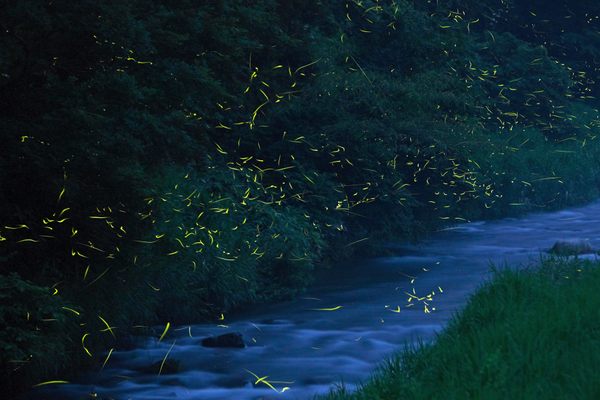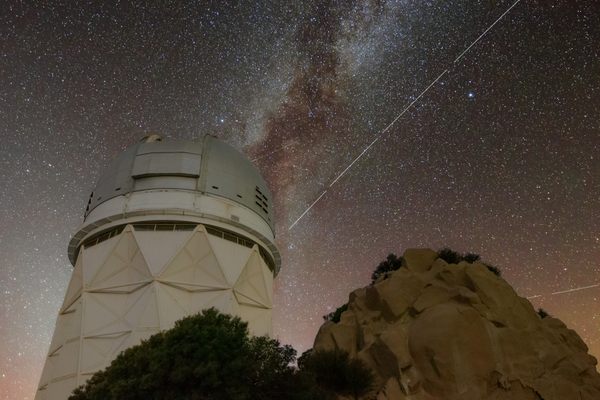Stargazing With Kids Is Fun, Free, and Full of Possibility
Stay up way past bedtime with us to explore new worlds of wonder with a child’s-eye view.
Atlas Obscura’s Wondersky columnist Rebecca Boyle is an award-winning science journalist and author of the upcoming Our Moon: How Earth’s Celestial Companion Transformed the Planet, Guided Evolution, and Made Us Who We Are (January 2024, Random House). Throughout the summer, she’ll be sharing the stories and secrets of our wondrous night sky.
When you were a kid, chances are you spent at least one starry night outside, looking up in awe and curiosity—and maybe confusion—about everything up there. If you have children in your life, this experience is one of the most fun things you can offer during summertime (besides, I suppose, a trip to the pool or some ice cream).
Kids love being outside past sunset and up way past their bedtimes. Ask me how I know. But when they have a reason to do so in their own backyard, it’s pure fun, rather than fun punctuated by difficult transitions like, “the fireworks are over/we’re leaving in the bottom of the ninth/we have a long ride home” or what have you.
Stargazing with kids is something you can do from anywhere, for free. But it will be easier and more fun if you invest a little bit of time in preparing and managing expectations. Remind them that waiting for the darkness is not easy, but it will be worth it.
You will want to familiarize yourself with the sky, even just a tiny bit, to help kids find their way around. If you aren’t sure how to find waypoints like the bright stars Vega, Polaris, or Arcturus, I highly recommend downloading a stargazing app on your phone or device. I use Star Walk 2 because I love its red-light night mode (available on iOS and Android) and Stellarium, both web and mobile. These apps use your phone’s location settings and gyroscope: You simply point the back of your phone at the sky and the screen labels everything you’re seeing.
(Some stargazers use a laser pointer, which I don’t recommend; accidentally looking directly into the laser can cause severe retinal damage, and shining it at a passing airplane can momentarily blind the pilot. It’s easier and safer to use an app, or a planisphere and a red flashlight.)

The Moon is an obvious and lovely target for young skywatchers. It’s also fun to look at the Moon through binoculars, and try to spot areas such as the Sea of Tranquility, where humans first landed on the Moon 54 years ago this month. For a rough way to locate the landing site, imagine the full Moon as a clock face, with 12 at the top and 6 at the bottom. From Earth’s Northern Hemisphere, the Sea of Tranquility—long thought to be an ocean but actually a dry lava plain—is the dark smudge between 2 and 3 o’clock. If you imagine the clock striking 3, the Apollo 11 site would be roughly near the tip of the hour hand, along the inner edge of the smudge. The lunar lander is far too small to see from Earth, however, even with a powerful telescope.
You don’t need a telescope, even in brightly lit suburbs or cities, for kids to be able to spot many familiar constellations, including Sagittarius, as well as asterisms such as the Big Dipper. The Big Dipper is high overhead in the Northern Hemisphere and is one of the most indelible asterisms; once you’ve spotted it, you will likely never miss it again.
Sagittarius is a good target in the southern sky, near the bright stripe of the Milky Way if you’re somewhere dark enough to see that. The brightest stars in Sagittarius form a teapot shape, short and stout, with its handle pointing east and its spout pointing toward the Milky Way.
Did you find the Summer Triangle yet? If so, locate bright Altair, the star that is most distant from the other two. In the last week of July, it is near the Milky Way. You can use Altair to find an intriguing dark smudge that is fun to see through binoculars: Barnard’s E nebula. This is a confusing name, because to me it resembles the letter U (or maybe an E laying on its side).
From Altair, look slightly up to find the orangey star called Tarazed. Center Tarazed in your binoculars, and just west of the star you will notice a dark letter U within the fuzzy haze of the Milky Way. This is not empty space, but instead a region of extremely cold and dark gas—it’s so cold that it’s near absolute zero. The atoms in this cloud of gas will eventually form new stars.

If you have a telescope or can borrow one, try finding some nebulae or star clusters. Kids might need a step stool to reach the eyepiece, and encourage them to use their hand to cover up whichever eye they’re not using to look through the telescope. It’s easier than squinting. A great July target is the star cluster known as Messier 92, which is a very ancient clump of stars that are bound together by gravity and collectively orbit our galaxy. M92 is one of the brightest globular clusters, which get their name from their globe-like appearance, as opposed to a more loosely defined “open cluster,” like the Beehive Cluster.
M92 is found high in the sky in July, closer to the horizon than Vega and to the left “side” of the constellation Hercules. You can see it with unaided eyes from a very dark site, but it just looks like a bright star. Binoculars will make M92 seem like a shaggy, diffuse star, and a telescope will reveal its true nature. The best photo I have ever seen is from the Hubble Space Telescope.
For tips on using a telescope with kids, check out 50 Things to See With A Telescope (Kids) by John A. Read.
For more on learning the constellations, and many other outdoorsy ideas that your middle-grade child can learn on their own, check out Catch A Crayfish, Count the Stars by Steven Rinella
And if you’re worried the youngest stargazers will be sleepy the next day, just remember that you only get about 15 summers to do this. Might as well enjoy them. And what’s more, bedtime is an arbitrary human construct. Just maybe don’t tell the kids that part.
Is there something you’d like to know about our brilliant night sky? Share your stargazing questions with us and you may see them answered in a future Wondersky column!
Each item is independently selected by our editorial staff. If you buy something through our links, Atlas Obscura may earn an affiliate commission.














Follow us on Twitter to get the latest on the world's hidden wonders.
Like us on Facebook to get the latest on the world's hidden wonders.
Follow us on Twitter Like us on Facebook